Barrett M107A1 20″ .50 BMG Semi-Auto Rifle, Flat Dark Earth Cerakote – 18066 For Sale
$12,999.99
The Barrett M107A1 20″ .50 BMG Semi-Auto Rifle in Flat Dark Earth Cerakote (model 18066) represents a culmination of over 35 years of precision engineering and military expertise, integrating cutting-edge technology with the renowned reliability of Barrett firearms. Retaining the familiar aesthetic and performance, the M107A1 distinguishes itself with significant advancements, including a modern design and superior materials that make it 4 pounds lighter than previous models while maintaining strength and durability. Key features include a suppressor-ready muzzle brake for reduced firing signature, enhancing stealth capabilities in tactical operations, and a lightweight quick-detach titanium bipod for stability across various terrains. Equipped with backup iron sights for versatility, the M107A1 is engineered for exceptional performance, accuracy, and resilience, exemplifying advanced military firearm innovation to meet rigorous mission demands.
What is the difference between M107A1 and M82A1?
The M107A1 and M82A1 are both .50 caliber sniper rifles developed by Barrett Firearms Manufacturing. The primary differences between the two are based on updated design features and materials:
1. **Weight and Materials**: The M107A1 is lighter than the M82A1 due to the use of more advanced materials, including a titanium construction of certain parts, which reduces overall weight.
2. **Design Improvements**: The M107A1 has several design improvements over the M82A1, including enhancements for better accuracy and recoil management. It features a redesigned muzzle brake and an enhanced lightweight modular handguard.
3. **Suppression Ready**: The M107A1 is designed to be more suppressor-ready, with its design accommodating the addition of a suppressor more effectively than the M82A1.
4. **Enhanced Features**: The M107A1 comes with advanced features such as a new rear grip, improved bipod, and an integrated rail system for mounting optics and other accessories.
These differences reflect Barrett’s ongoing efforts to improve the performance and operational adaptability of their sniper platforms.
Can you legally own a Barrett 50 cal?
Yes, in the United States, it is generally legal to own a Barrett .50 caliber rifle, as long as you comply with federal and state laws regarding firearms ownership. You must be at least 18 years old to purchase a rifle from a licensed dealer, and you are required to pass a federal background check. Additionally, some states and localities have specific restrictions or bans on .50 caliber rifles, so it’s important to check the laws in your area to ensure compliance. Always ensure you are following all applicable laws and regulations regarding firearm ownership and usage.
What is the range of the m107a1 sniper rifle?
The range of the Barrett M107A1 sniper rifle is approximately 1,800 meters (about 1.1 miles) for effective targeting.
Are Barrett rifles worth the money?
The worth of Barrett rifles can vary depending on several factors, including intended use, budget, and personal preferences. Here are some points to consider:
1. **Quality and Performance**: Barrett rifles, known for their high quality and robust performance, are often praised for their long-range accuracy and durability.
2. **Intended Use**: If you need a rifle for long-range shooting, military, or law enforcement purposes, a Barrett might be worth the investment. However, for general hunting or casual shooting, they may be more powerful and expensive than necessary.
3. **Cost**: Barrett rifles are typically expensive, often running into several thousand dollars. This might be justified if their specific capabilities align with your needs.
4. **Resale Value**: High-quality firearms like Barretts tend to hold their value well, which might be a consideration if you plan to sell in the future.
5. **Personal Preference**: Brand reputation, design, and personal experience also play roles in determining value.
Ultimately, whether a Barrett rifle is worth the money depends on your specific circumstances and priorities.
Is the 416 Barrett better than the 50 BMG?
The effectiveness of the .416 Barrett versus the .50 BMG can depend on the context in which they’re being used, as they have different strengths:
1. **Ballistics and Range:** The .416 Barrett is known for its high ballistic coefficient and is designed to perform well at long ranges. It typically offers a flatter trajectory and better wind resistance compared to the .50 BMG, making it effective for precision shooting at extended distances.
2. **Recoil and Portability:** The .416 Barrett generally has less recoil than the .50 BMG, which can be beneficial for shooter comfort and follow-up shots. Additionally, rifles chambered in .416 Barrett might be lighter and more portable, useful for certain tactical situations.
3. **Penetration and Power:** The .50 BMG, with its larger and heavier bullet, generally offers more raw power and penetration capabilities, making it more effective against fortified or hardened targets. This makes it the preferred choice for certain military applications, such as disabling vehicles or equipment.
4. **Availability and Cost:** The .50 BMG is more widely used and has a greater variety of ammunition types available. The .416 Barrett, being more specialized, might have less available options and potentially higher costs for ammunition and rifles.
Ultimately, the “better” cartridge will depend on the specific requirements of the user and the intended use case. Each cartridge has its distinct advantages that can make it the preferable choice in different scenarios.
Is the M107 a sniper rifle?
Yes, the M107 is a sniper rifle. It is a semi-automatic, long-range sniper rifle used by military forces. Its design is based on the Barrett M82, and it’s known for its powerful .50 BMG (Browning Machine Gun) caliber, enabling it to engage targets at great distances.
What states ban 50 cal rifles?
As of the latest available information, the states that have implemented bans or strict regulations on .50 caliber rifles include California and Connecticut. It’s important to verify with current state laws as legislation can change.
What does BMG stand for in guns?
In the context of guns, “BMG” stands for “Browning Machine Gun.” It is most commonly associated with the .50 BMG cartridge, which was developed for the Browning M2 machine gun.
Can you hunt deer with a Barrett 50 cal?
Yes, you can technically hunt deer with a Barrett .50 cal, as there are no federal laws specifically prohibiting the use of such a firearm for hunting. However, hunting regulations vary significantly by state and local jurisdictions, and many places have specific rules regarding the caliber, type of firearm, and ammunition that can be used for deer hunting. These laws often focus on ensuring a quick and humane kill and conserving the deer population.
Using a Barrett .50 cal for deer hunting is generally considered excessive due to its immense power and range, which can result in over-penetration and unnecessary destruction of the game. It is essential to check and follow your local wildlife regulations and ethical hunting guidelines.
What sniper did Chris Kyle use?
Chris Kyle, the renowned Navy SEAL sniper, primarily used a .300 Winchester Magnum sniper rifle and a 7.62 NATO Mk 11 semi-automatic rifle during his service. These rifles were among the tools he used for precision and effectiveness in various operations.
What sniper rifle is used by secret service?
The U.S. Secret Service uses a variety of firearms for different purposes, but for sniper operations, they have utilized rifles like the H&K 416 and the Remington 700 series, particularly customized for their needs. These rifles are chosen for their accuracy, reliability, and adaptability to various operational scenarios. However, specific models and details might change over time due to advancements in technology and operational requirements.
What is the best sniper rifle in the world?
Determining the “best” sniper rifle is subjective and can vary based on specific criteria such as accuracy, range, durability, and user preference. However, some rifles are frequently mentioned among the top due to their performance and reputation:
1. **Barrett M82/M107**: Known for its long range and powerful .50 BMG caliber, it is highly effective for anti-material and long-distance targets.
2. **Accuracy International AXMC**: Renowned for its modularity, precision, and reliability, often used by military and law enforcement.
3. **CheyTac M200 Intervention**: Famous for its exceptional range and accuracy, popularized by media though its real-world usage is more limited.
4. **Sako TRG 42**: Known for excellent accuracy and reliability, used by various military forces.
Ultimately, the choice of the best sniper rifle will depend on the specific requirements and context of use, such as military specifications, terrain, and mission objectives.
What is the difference between 50 cal and 50bmg?
The term “50 cal” is often used informally to refer to firearms and ammunition with a .50 caliber, which means the diameter of the bullet is approximately 0.50 inches. However, “.50 cal” is a broad term and can refer to different types of ammunition and firearms.
“.50 BMG” (Browning Machine Gun) specifically refers to a type of .50 caliber cartridge: the .50 BMG (12.7×99mm NATO). This cartridge was originally designed for the M2 Browning machine gun and is now used in various rifles and machine guns. The .50 BMG is characterized by its large cartridge size, high power, and long-range capabilities and is distinct from other .50 caliber rounds due to its specific dimensions and performance characteristics.
In summary, while “50 cal” can generally refer to several types of .50 caliber ammunition, “50 BMG” specifically refers to the .50 BMG cartridge.
What is the difference between the Barrett M95 and M107?
The Barrett M95 and M107 are both rifles designed by Barrett Firearms Manufacturing, but they serve different roles and have distinctive specifications:
1. **Purpose and Role:**
– **Barrett M95:** This is a bolt-action sniper rifle designed for long-range precision shooting. It is praised for its accuracy and is often used in situations where a compact, high-power rifle is needed.
– **Barrett M107:** This is a semi-automatic, anti-material rifle, also known as the Barrett M82 in some versions. It is intended for engaging materials and light vehicles, as well as explosive ordnance disposal; it’s not designed to be as precise as dedicated sniper rifles.
2. **Action Type:**
– **M95:** Bolt-action, which generally provides better accuracy for single shots since each round can be loaded precisely by hand.
– **M107:** Semi-automatic, allowing for quicker follow-up shots which is beneficial in combat settings.
3. **Design and Size:**
– **M95:** More compact and lighter, with a bullpup design, which places the action and magazine behind the trigger, reducing overall length while maintaining a long barrel.
– **M107:** Larger and heavier, with a traditional rifle layout, contributing to its heavy recoil absorption design which is crucial for the powerful rounds it fires.
4. **Caliber:**
– Both rifles are typically chambered for the .50 BMG (Browning Machine Gun) cartridge, which is a large caliber intended for long-range and anti-material tasks.
5. **Operational Differences:**
– **M95:** Requires manual operation of the bolt-action mechanism after each shot, meaning a slower rate of fire compared to the M107.
– **M107:** Allows for quicker consecutive shots due to its semi-automatic operation, making it more suitable in rapidly changing tactical environments.
In summary, the primary differences lie in the action type, purpose, design, and application. The M95 is optimized for long-range precision, whereas the M107 is designed for rapid fire in anti-material roles or combat scenarios.
What is the speed of the Barrett M107A1 bullet?
The Barrett M107A1 fires a .50 BMG (Browning Machine Gun) cartridge, and the muzzle velocity is approximately 2,800 to 2,900 feet per second (around 853 to 884 meters per second), depending on the specific ammunition used.
| Product Line | M107A1 |
|---|---|
| Action | Semi-Auto |
| Overall Length | 48" |
| Magazines Included | 1 (10 Round) |
Be the first to review “Barrett M107A1 20″ .50 BMG Semi-Auto Rifle, Flat Dark Earth Cerakote – 18066” Cancel reply
Related products
Barrett M107A1
Barrett Firearms M107 A1 .50 BMG Semi-Automatic Rifle, Gray Cerakote/Black Parkerized – 14552
Barrett M107A1
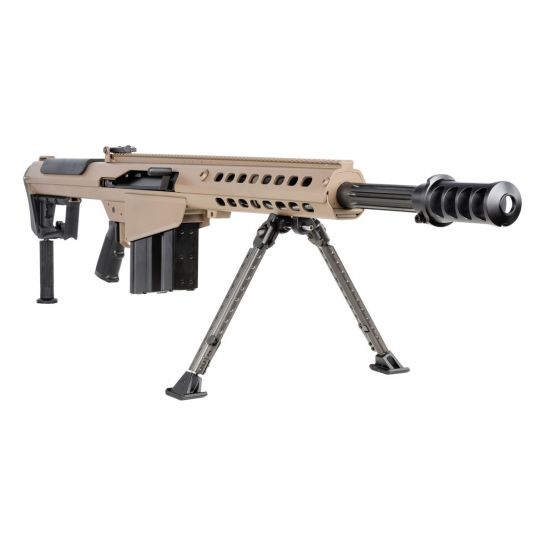
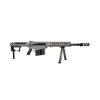
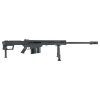
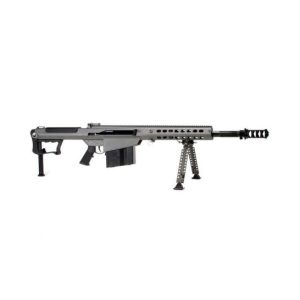
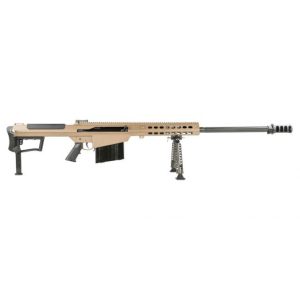
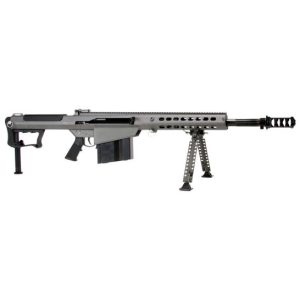
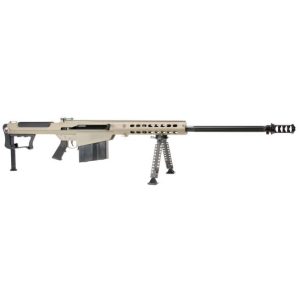
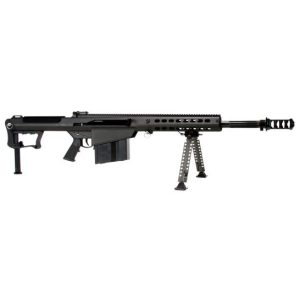
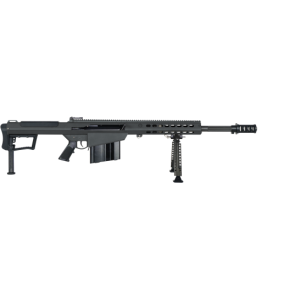
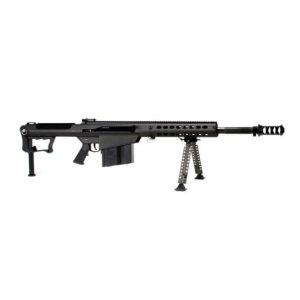
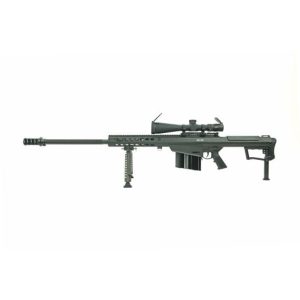
Reviews
There are no reviews yet.